Crime Statistics 2024 – By Location, Country, Demographics, Frequency and Types
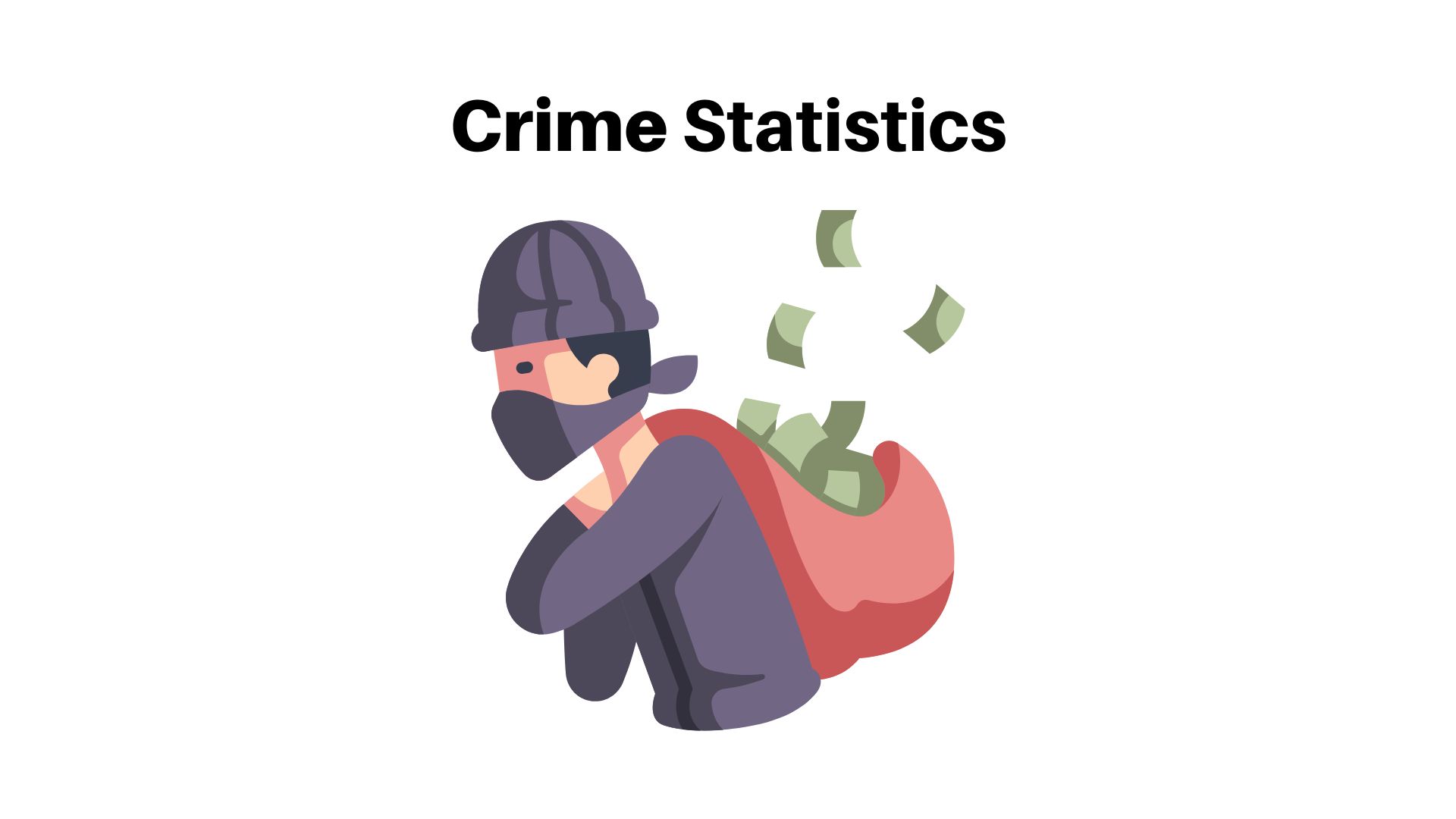
Page Contents
- Introduction
- Editor’s Choice
- Facts About Crime
- What Includes Crime?
- Types of crimes
- How To Stop a Crime?
- General Crime Statistics
- Crime Statistics By Locations
- Crime Statistics By Country
- By Topmost Peaceful Countries
- By The Highest Crime Index
- By Lowest
- Crime Statistics By Frequency
- Crime Statistics By Demographics
- By Victims
- By Ethnic Background (Victims)
- By An External Perpetrator
- Crime Statistics By Types
- Trends in Crime Statistics
- Recent Developments in Crime Statistics
- Conclusion
Introduction
Crime Statistics: crime statistics provide crucial insights into societal trends and safety measures. According to recent data, crime statistics reveal that the United States witnessed over 1.2 million violent crimes in 2020 alone, encompassing offenses such as murder, assault, and robbery. Additionally, property crimes amounted to approximately 6.2 million incidents during the same period, including burglary, theft, and vehicle theft. These numbers paint a vivid picture of the prevalence and impact of criminal activities within the nation. By analyzing crime statistics, we can identify patterns, assess risk factors, and devise strategies to enhance public safety and security.
As such, understanding the nuances of crime data is paramount for businesses, policymakers, and communities alike in fostering environments conducive to growth and well-being.
Editor’s Choice
- Firearm cases contribute to approximately 73.7% of murder cases, highlighting a concerning trend in violent crime.
- 51% of residents in the United States of America perceive crime as a major problem, indicating widespread concerns about public safety.
- The majority of crime occurs in the homes of victims or residential areas, accounting for 32.2% of reported incidents.
- Iceland secured the title of the world’s most peaceful country in 2022, boasting an index value of 1.1, reflecting its low crime rates and peaceful environment.
- Venezuela holds the unfortunate distinction of having the highest Crime index relative to its population in 2023, with a staggering index value of 83.76, underscoring significant challenges related to crime and security.
- In the United States of America, a rape case is observed every 3.8 minutes, indicating the prevalence of sexual violence and the urgent need for intervention and support.
- Japan reports that 12% of its population either experienced a crime or knows someone who has suffered from it in the last 12 months, indicating widespread awareness of criminal activities.
- Homicide claims the lives of approximately 100 people each day in the United States of America, highlighting the grave consequences of violent crime on communities.
- According to Crime statistics, 45% of people from white backgrounds are victims of crime, shedding light on the disproportionate impact of criminal activities on certain demographics.
You May Also Like To Read
- Human Trafficking Statistics
- Domestic Violence Statistics
- Sexual Assault Statistics
- FBI Crime Statistics
- Referral Marketing Statistics
- Prison Statistics
- GDPR Statistics
- Piracy Statistics
- Notable Ransomware Statistics
- DDoS Statistics
- Divorce Statistics
Facts About Crime
- Crime rates vary significantly across different regions and demographics.
- The types of crimes committed can range from theft and burglary to more serious offenses like assault and murder.
- Factors such as socioeconomic status, community cohesion, and law enforcement effectiveness can influence crime rates.
- Crime statistics provide valuable insights into trends and patterns, helping policymakers and law enforcement agencies develop effective strategies for crime prevention and reduction.
- Technology and data analytics play an increasingly important role in crime prevention and detection efforts.
- Crime has both direct and indirect costs to society, including expenses related to law enforcement, the criminal justice system, and victim support services.
- Public perceptions of safety and security can impact various aspects of daily life, including economic activities and community well-being.
- Collaborative efforts involving government agencies, community organizations, and private sector stakeholders are essential for addressing crime effectively.
- Crime prevention initiatives often focus on addressing underlying social and economic factors that contribute to criminal behavior.
- Victim support services play a crucial role in helping individuals and communities recover from the impacts of crime.
What Includes Crime?
A crime is an illegal act of hurting an individual, living, or non-living thing, or illegal activities carried out in companies. It may include cases of theft, rape, or murder. Any type of illegal activity carried out is liable for punishment by the government’s law. Nowadays, cybercrimes such as hacking, digital crimes, etc.… are increasing because of technological developments. These types of new crimes are occurring because the darknet on the internet has many hackers and many times it is difficult to track such persons. Corporate companies experience major cybercrime attacks on the highest level.
Types of crimes
- Hate Crime – Includes offenses against a certain group of people such as LGBTQIA+, and religious groups resulting in property damages, vandalism, etc.…
- Crime against Humanity – These types of crimes are against a group of people to harm, kill, and destroy such as war crimes, or crimes against civilians.
- Organized Crime – These types of crimes are conducted by a group of people or organizations. Examples of organized crime are money laundering, drug, or human trafficking, gambling, extortion, racketeering, etc.…
- White collar crimes – These types of crimes are often conducted by people in the organization working in high positions for the means of financial benefits. It includes fraud, embezzlement, or money laundering.
- Statutory crimes – Statutory crimes are recognized by the laws of each country. It includes traffic offenses, DUI, or drug offenses.
- Inchoate Crimes – These crimes are incomplete. And mostly labeled as attempted crimes. They include examples such as solicitation or conspiracy.
- Personal crimes – Personal crimes are conducted for emotional, psychological, or physical damage to the victim. It includes rape, kidnapping, murder, and assault.
- Property crimes – Property crimes are identified based on damage or destruction of another person’s property. Examples are burglary, theft, vandalism, etc.…
- Crime against morality – In crime against morality cases, no actual proof is found but and are victimless cases. Examples are drug use, gambling, prostitution, etc.
How To Stop a Crime?
- Keep your door locked.
- Don’t showcase your money, properties, or any kind of valuable information to an external person.
- Conduct audits in the companies regularly.
- Put warning signs around the societies or houses to keep criminals out of reach.
- Install security cameras.
- Report any suspicious event to the police department.
- Adopt dog.
General Crime Statistics
- 51% of the residents in the United States of America see crime as a major problem.
- Every new day, homicide kills around 100 people in the United States of America.
- According to Crime Statistics, Firearm cases contribute to around 73.7% of murder cases.
- Bias incidents increase by 229% in the year 2022.
- In the year 2022, Fraud crimes increased by 43% by recording around 16,202 cases.
- Over the year, Kidnapping, theft, murder, and assault-related cases increased by 36%, 23%, and 21% respectively.
Crime Statistics By Locations
- Crime statistics say that the majority of crime takes place in the homes of the victims or residential areas resulting in 32.2%.
- 2% of cases are observed on unknown roads or locations.
- Furthermore, 2.8% and 2.7% of crimes take place in restaurants or playgrounds, or parks respectively.
- 7% of the crimes occur in garages or parking lots.
- 1% of cases are observed in colleges and schools.
- And 16.9% of cases occurred on highways, streets, or sidewalks
Crime Statistics By Country
By Topmost Peaceful Countries
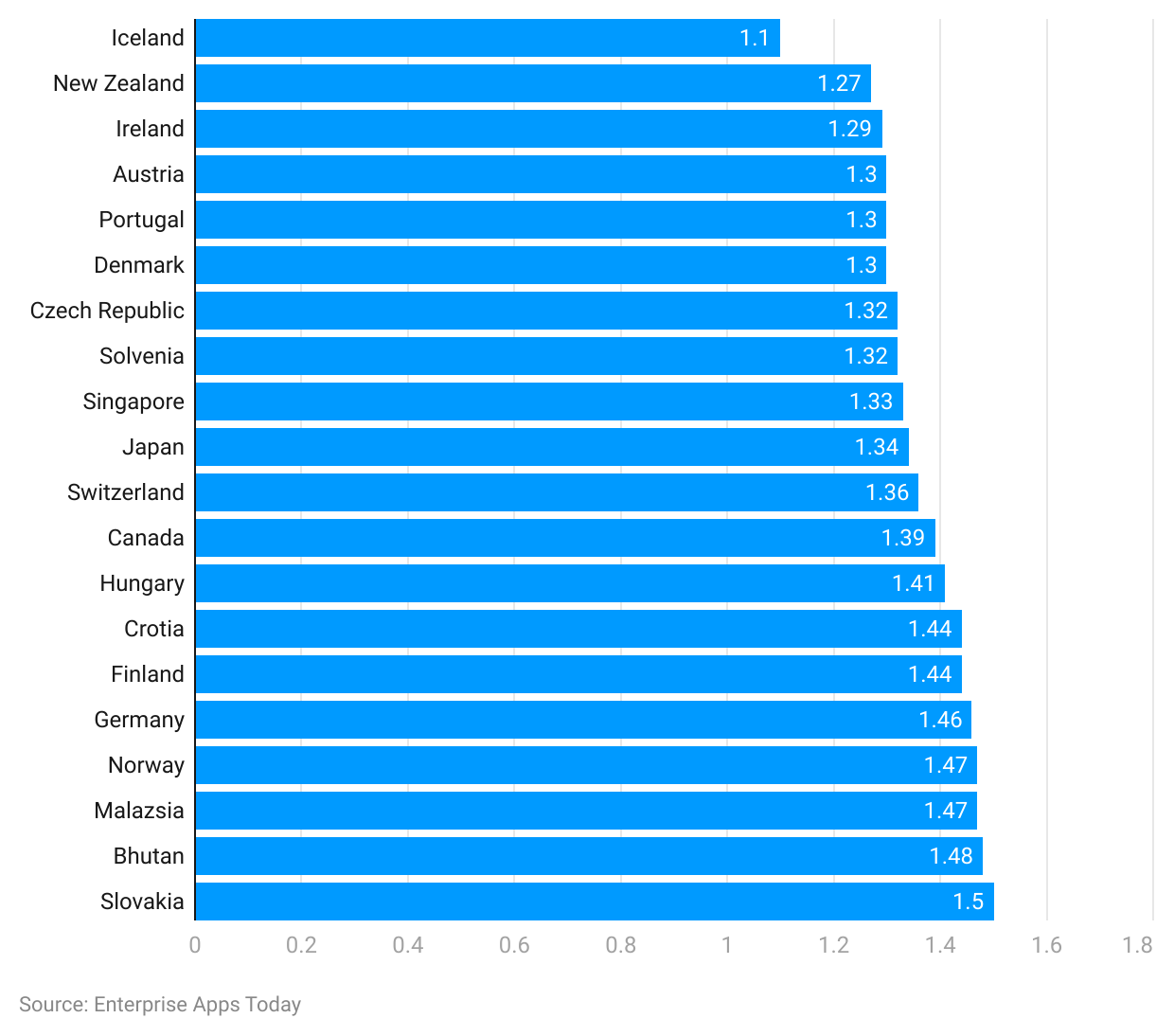 (Reference: Statista)
(Reference: Statista)
- According to Crime Statistics, Iceland has ranked the world’s most peaceful city in the year 2022 with an index value of 1.1.
- Similarly, New Zealand and Ireland ranked second and third with an index numbers of 1.27 and 1.29.
- Other names in the list of top peaceful countries as of 2022 are Austria, Portugal, Denmark (1.3), Czech Republic, Slovenia (1.32), Singapore (1.33), Japan (1.34), Switzerland (1.36), Canada (1.39), Hungary (1.41), Croatia, Finland (1.44), Germany (1.46), Norway, Malaysia (1.47), Bhutan (1.48), and Slovakia (1.5).
By The Highest Crime Index
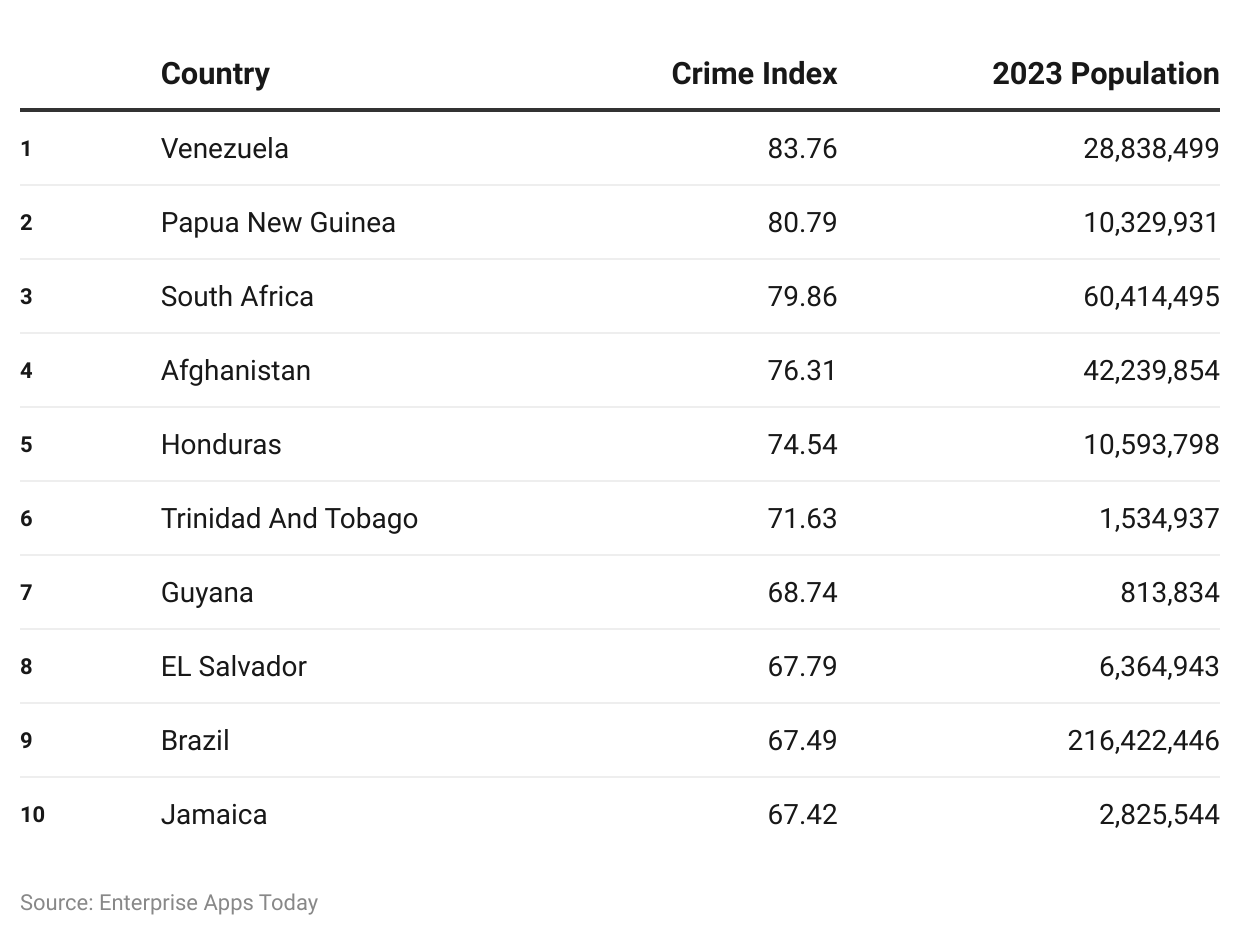 (Reference: worldpopulationreview.com)
(Reference: worldpopulationreview.com)
- As stated by the Crime Statistics, Venezuela has the highest Crime index as compared to the population in the year 2023 of 28,838,499 resulting in 83.76.
- Papua New Guinea and South Africa ranked respectively following Venezuela resulting in 80.79 and 76.86 with a population of 10,329,931 and 60,414,495.
- Other names in the list of highest crime rates by country are Afghanistan: 76.31 (42,239,854), Honduras: 74.54 (10,593,798), Trinidad and Tobago: 71.63 (1,534,937), Guyana: 68.74 (813,834), El Salvador: 67.79 (6,364,943), Brazil 67.49 (216,422,446) and Jamaica 67.42 (2,825,544).
By Lowest
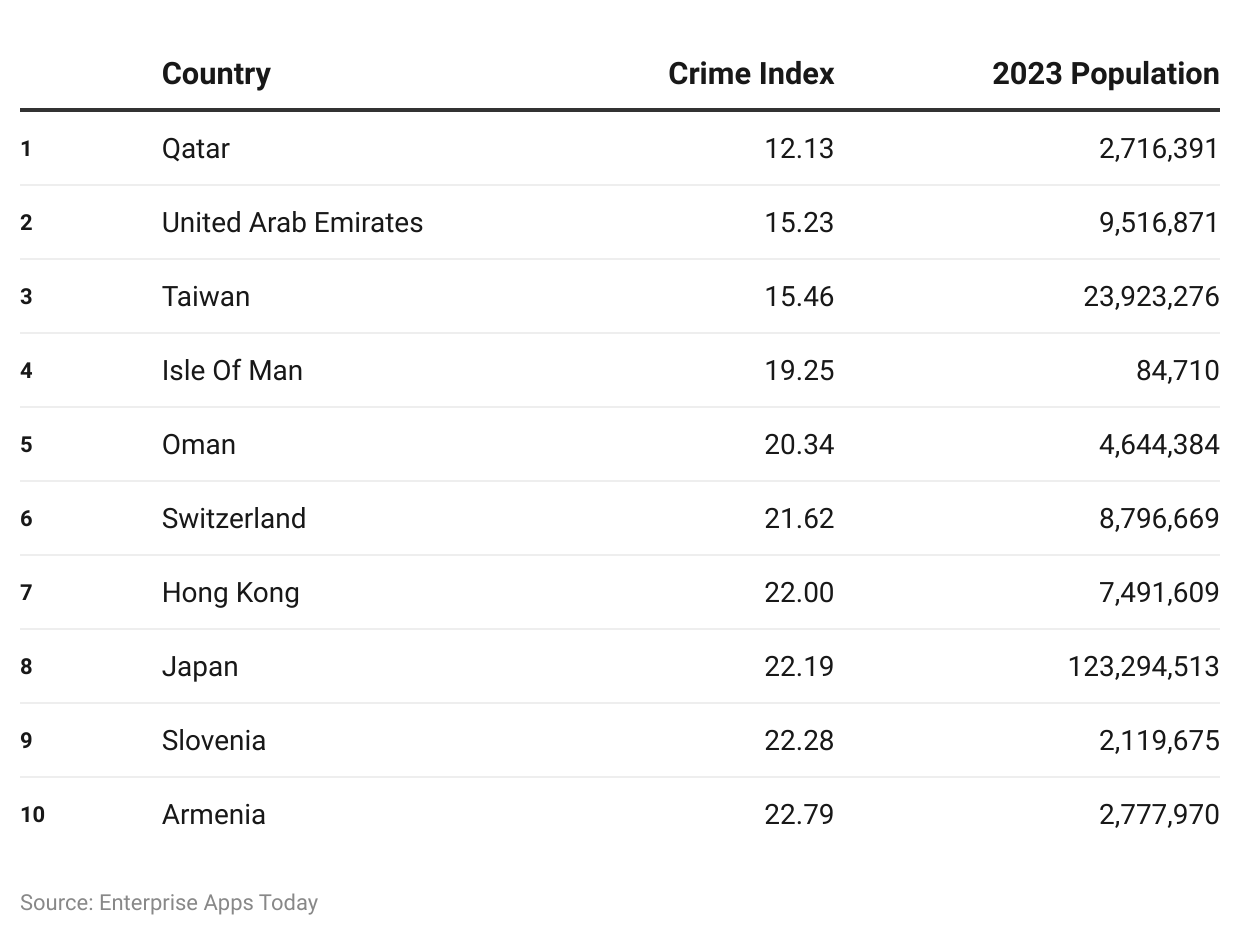 (Reference: worldpopulationreview.com)
(Reference: worldpopulationreview.com)
- On the other hand, the top three countries for the lowest crime index are Qatar (population: 2,716,391), United Arab Emirates (population: 9,516,871), and Taiwan (population: 23,923,276), at 12.13, 15.23, and 15.46.
- Other names followed by the top three countries for the lowest crime index are the Isle of Man: 19.25 (84,710), Oman 20.34 (4,644,384), Switzerland 21.62 (8,796,669), Hong Kong 22 (7,491,609), Japan 22.19 (12,294,513), Slovenia 22.28 (2,119,675), and Armenia 22.79 (2,777,970).
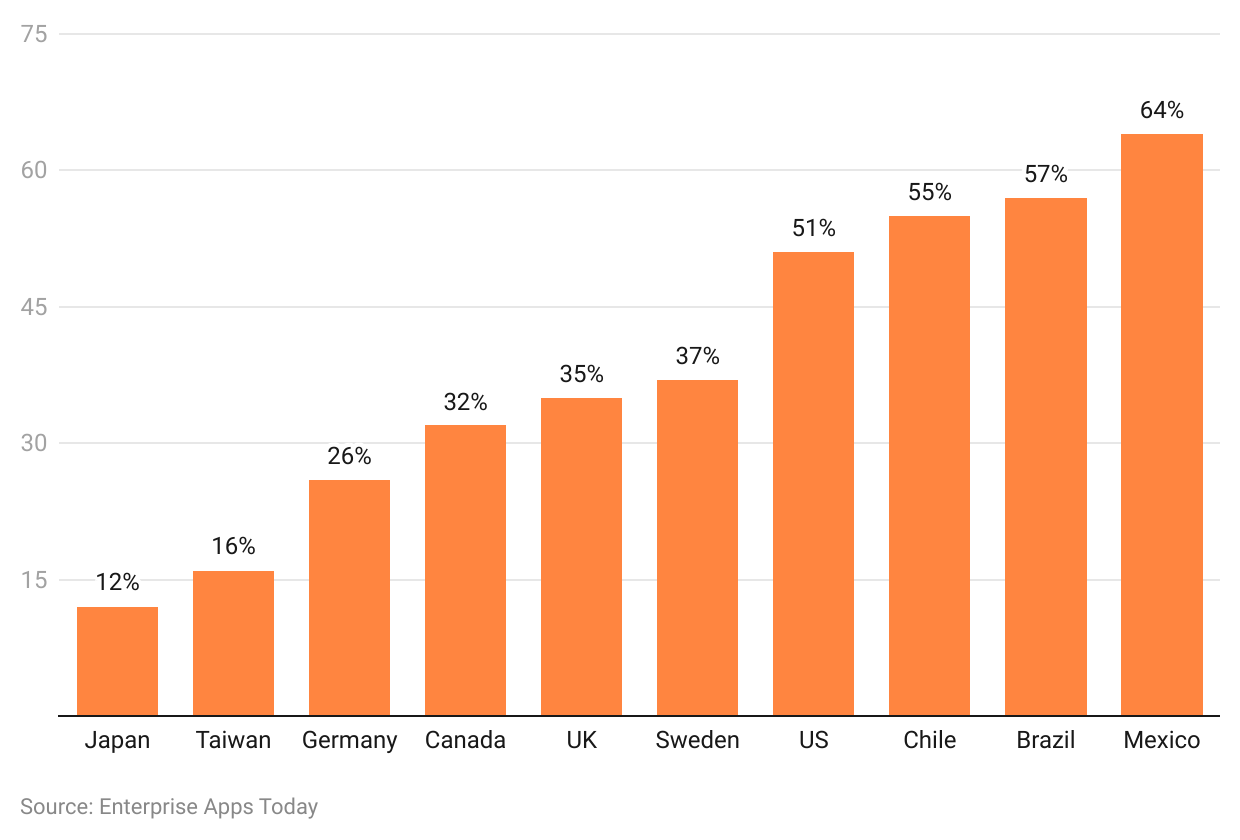
(Reference: AlfredCamera)
- In Japan, there were 12% of the people said they either experienced the crime or know someone who has suffered from it in the last 12 months.
- Similar to the above situation, the following are the rates for each ranked country as stated by Crime statistics: Taiwan (16%), Germany (26%), Canada (32%), United Kingdom (35%), Sweden (37%), United States of America (51%), Chile (55%), Brazil (57%) and Mexico (64%).
Crime Statistics By Frequency
- In the United States of America, every 3.8 minutes rape case is observed.
- For every 32.5 minutes, a murder case occurs.
- For every 26.2 seconds, a violent crime occurs in the United States of America
- Similarly, every 39.2 minutes an aggravated assault takes place.
- For every 1.9 minutes, a case of robbery takes place in the United States of America.
- A property crime takes place every 4.4 seconds.
- And, in the United States of America, for every 42.2 seconds and 25.7 seconds, a case of vehicle theft or burglary has taken place respectively.
Crime Statistics By Demographics
By Victims
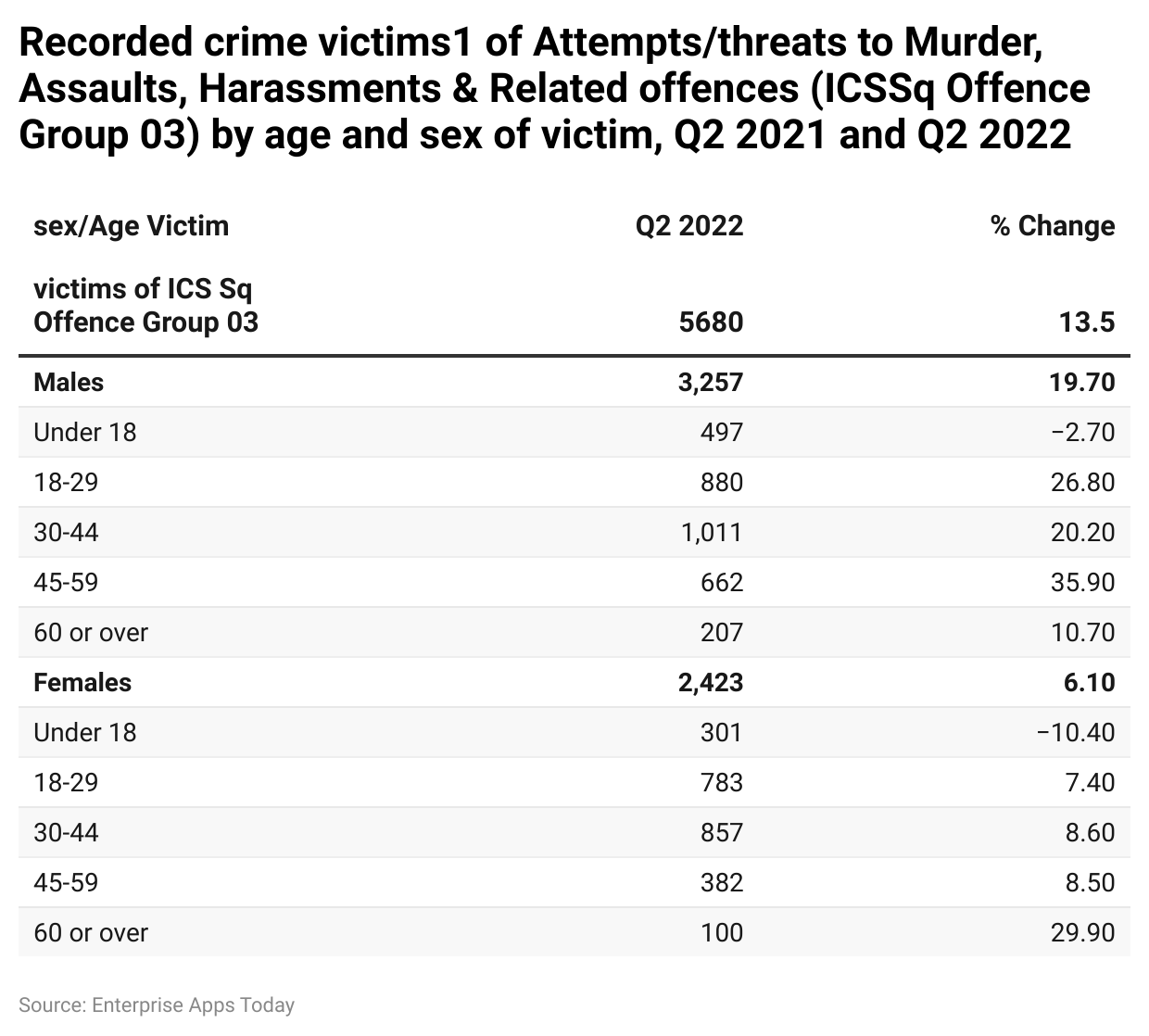 (Source: Central Statistics Office)
(Source: Central Statistics Office)
- The above chart provides information on the demographical insight of victims of murder, threats, assaults, harassment, or related offenses.
Males:
- In the year 2022, the reported number of cases for boys under 18 years was 497. Fortunately, the number received a negative minus change by -2.7% as compared to the year 2021.
- Similarly, men in other age groups reported the following number of cases and a change in the total number compared to the previous year: 18 years to 29 years: 880 (28.8%),30 years to 44 years: 1,011 (20.2), 45 years to 59 years: 662 (35.9%), 60 years and above 207 (10.7%).
Females:
- Girls below the age of 18 reported 301 crime cases with a -10.4 % crime rate compared to the previous year.
- Similarly, women in the other age groups reported the following number of cases and a change in the total number compared to the previous year. 18 years to 29 years: 783 (7.4%), 30 years to 44 years: 857 (8.6%), 45 years to 59 years: 382 (8.5%), and 60 years and above: 100 (29.9%).
By Ethnic Background (Victims)

(Source: seattle.gov)
- As stated by Crime statistics, 45% of people from white backgrounds fall prey to the unfortunate event.
- Similarly, there are 35% of the people from black or African American backgrounds suffer from various crime cases.
- 13% of the population belong to Asian/Pacific Islanders and 4% respectively are American Indian/ Alaska Native or from unspecified ethnic backgrounds.
By An External Perpetrator
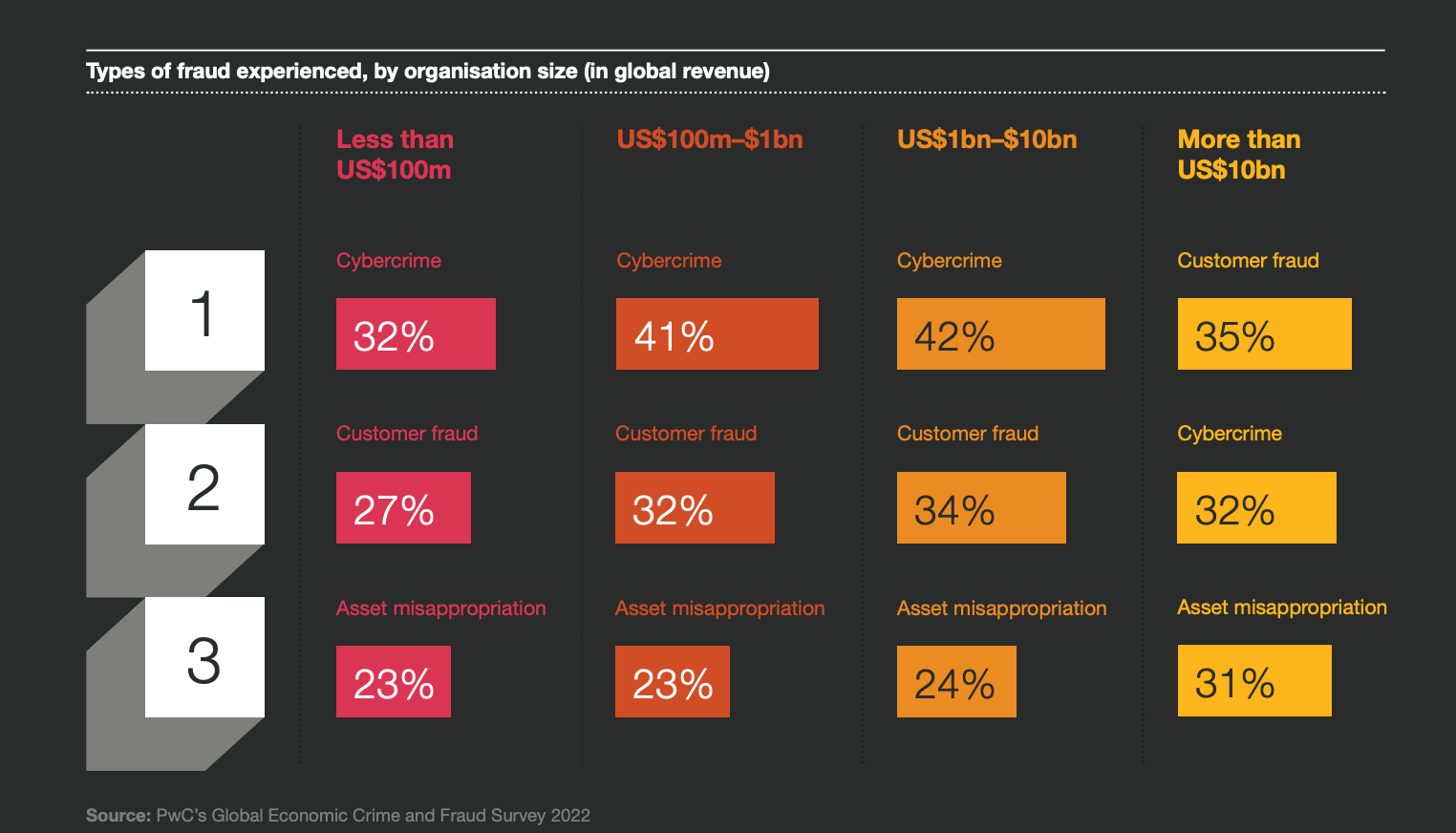 (Source: pwc.com)
(Source: pwc.com)
- In the case of corporate crime statistics, the highest number of criminal activities were performed by hackers outside the organization resulting in 31%.
- On the other hand, 29% of the crimes were performed by the company’s customers 28% were observed from organized crimes.
- 20% of the cases occurred due to vendor/supplier and 15% were recorded from agent/intermediary.
- Furthermore, Crime Statistics say that other people who were involved in performing the crime were competitors (14%), Joint venture/ alliance partners (12%), Shred service providers (12%), consultants or advisers (10%), and Foreign states (9%).
Crime Statistics By Types
By Frauds Experienced By Companies
 (Source: pwc.com)
(Source: pwc.com)
- The most common type of crime faced by any type of company is Cybercrime as stated by Crime statistics of 2022.
- Companies with less than $100 million of revenue experienced crimes such as Cybercrime (32%), Customer Fraud (27%), and Asset misappropriation (23%).
- Companies with a revenue of $100 million to $1 billion of revenue experienced crimes such as Cybercrime (41%), Customer Fraud (32%), and Asset misappropriation (23%).
- Similarly, companies with a revenue of $1 billion to $10 billion of revenue experienced Cybercrime (42%), Customer fraud (34%), and asset misappropriation (24%).
- And companies with revenue of more than $10 billion of revenue experienced Customer fraud (35%), Cybercrime (32%), and asset misappropriation (31%).
By Frauds Experienced By Industries
(Source: pwc.com)
- If we look at the crime statistics of industry-based events the insights provide the following information.
Industrial manufacturing
- Cybercrime (32%)
- Asset misappropriation (28%)
- Accounting/ financial statement fraud (24%)
Financial Service
- Customer fraud (44%)
- Cybercrime (38%)
- Know your customer failure (29%)
Energy, Utilities, and resources
- Procurement fraud (45%)
- Cybercrime (29%)
- Supply chain fraud (29%)
Retail and consumer
- Customer fraud (37%)
- Asset misappropriation (31%)
- Cybercrime (27%)
Government and public sector
- Cybercrime (36%)
- Asset misappropriation (33%)
- Customer fraud (28%)
Health Industry
- Cybercrime (40%)
- Asset misappropriation (30%)
- Customer fraud (27%)
Technology, media, and telecommunications
- Cybercrime (50%)
- Customer fraud (35%)
- Procurement fraud (26%)
Trends in Crime Statistics
- Crime rates tend to fluctuate over time, influenced by various factors such as economic conditions, social unrest, and changes in law enforcement strategies.
- Emerging trends in cybercrime and digital fraud highlight the need for enhanced cybersecurity measures and digital literacy programs.
- Urbanization and population growth can contribute to changes in crime patterns, with larger cities often experiencing higher crime rates compared to rural areas.
- Technological advancements, including surveillance systems and predictive analytics, are increasingly used to monitor and prevent criminal activities.
- Globalization has facilitated the spread of organized crime networks and transnational criminal activities, posing challenges for law enforcement agencies worldwide.
- Societal shifts and demographic changes, such as aging populations and shifts in immigration patterns, may influence the types and prevalence of crimes observed in communities.
- The COVID-19 pandemic has impacted crime trends, with disruptions to daily routines, economic hardships, and changes in law enforcement priorities leading to shifts in criminal behavior.
- Public awareness campaigns and community engagement initiatives play a vital role in raising awareness about crime prevention strategies and promoting community resilience against criminal activities.
- Collaboration between law enforcement agencies, government entities, and private sector organizations is essential for addressing emerging crime trends and ensuring public safety.
- Continuous monitoring and analysis of crime data help identify emerging threats and trends, enabling proactive responses and resource allocation to address evolving crime challenges.
Recent Developments in Crime Statistics
- Increased incidences of cybercrime and online fraud have been observed, with criminals exploiting vulnerabilities in digital systems amidst the shift towards remote work and online transactions during the COVID-19 pandemic.
- There is a growing concern over the rise in hate crimes and racially motivated incidents, highlighting the need for greater awareness, education, and measures to combat discrimination and promote inclusivity.
- Law enforcement agencies are leveraging data analytics and artificial intelligence tools to enhance crime prediction and detection capabilities, enabling more targeted interventions and resource allocation.
- Community policing initiatives have gained traction, emphasizing collaboration between law enforcement agencies and local communities to address underlying social issues and prevent crime through proactive engagement and support.
- The opioid epidemic continues to impact communities, with efforts focused on addressing substance abuse disorders, expanding access to treatment and rehabilitation services, and targeting drug trafficking networks.
- Instances of domestic violence and gender-based violence have garnered increased attention, prompting initiatives to strengthen support services for survivors, enhance legal protections, and raise awareness about prevention and intervention strategies.
- Legislative reforms and policy initiatives are being introduced to address systemic issues within the criminal justice system, including efforts to promote fairness, equity, and accountability in law enforcement practices and sentencing policies.
- The proliferation of illicit firearms and gun-related violence remains a significant concern, prompting calls for stricter gun control measures, enhanced background checks, and community-based violence prevention programs.
- Emerging technologies such as blockchain and cryptocurrency are being exploited by criminals for money laundering, illicit transactions, and ransomware attacks, necessitating regulatory measures and cybersecurity interventions to mitigate risks.
- International cooperation and coordination efforts are being intensified to combat transnational organized crime networks, human trafficking rings, and cybercriminal syndicates, emphasizing the importance of cross-border collaboration and information sharing among law enforcement agencies.
Conclusion
In conclusion, crime statistics provide valuable insights into the prevalence and dynamics of criminal activities, informing law enforcement strategies, policy decisions, and community interventions. The data reveals significant trends and challenges that necessitate proactive measures to ensure public safety and address underlying societal issues. With firearm-related cases contributing to approximately 73.7% of murder incidents and hate crimes on the rise, there is a pressing need for targeted interventions to prevent violence and promote social cohesion.
Furthermore, the alarming rate of cybercrime, with an estimated global cost of USD 1.79 trillion annually, underscores the importance of enhancing cybersecurity measures and digital literacy efforts. Despite efforts to combat crime, challenges such as underreporting and disparities in crime rates persist, highlighting the importance of comprehensive data collection and analysis. By leveraging data-driven approaches and fostering collaboration between law enforcement agencies, policymakers, and communities, we can work towards creating safer and more resilient societies for all.
Sources
FAQ.
You can report any seen or experienced crime to the nearest police station as soon as possible so that the person who conducted the crime does not get time to run away.
A person who conducts a crime is liable for imprisonment or any other type of punishment as decided by the law enforcement agency.
Some of the commonly found causes in the persons who conduct crime are mental illness, lack of education, financial stress, poverty, cultural factors, or child abuse
The major three crime types include misdemeanor, infraction, and felony.

Barry is a lover of everything technology. Figuring out how the software works and creating content to shed more light on the value it offers users is his favorite pastime. When not evaluating apps or programs, he's busy trying out new healthy recipes, doing yoga, meditating, or taking nature walks with his little one.